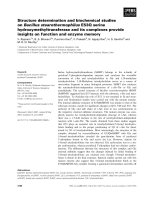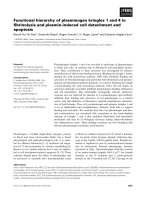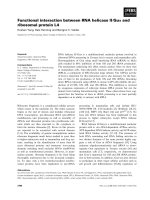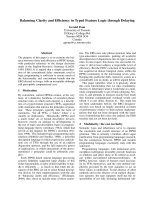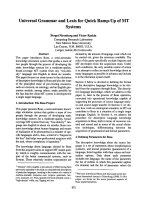báo cáo khoa học: " Functional genomic and epidemiological studies reveal novel genes regulating cholesterol metabolism" doc
Bạn đang xem bản rút gọn của tài liệu. Xem và tải ngay bản đầy đủ của tài liệu tại đây (178.33 KB, 3 trang )
Richardson and Ordovas: Genome Medicine 2009, 1:96
Abstract
Elevated plasma cholesterol is a heritable trait and a risk factor
for the development of cardiovascular disease. Although several
major biochemical pathways regulating cholesterol metabolism
have been identified, questions regarding the details of this
regulation remain. In fact, common genetic polymorphisms in
candidate genes explain only 5 to 7% of variation in high- and
low-density lipoprotein cholesterol levels between individuals.
This suggests that many of the factors influencing cholesterol
metabolism, and potentially the etiology of cardiovascular
disease, are unknown. Here, we review recent functional
genomic research that, combined with results from genome-
wide association studies, provides a powerful tool to identify
novel candidate genes relevant to cholesterol metabolism.
The role of cholesterol in the etiology of
cardiovascular disease
Cholesterol is an integral component of lipid membranes
in eukaryotic cells that is required for maintaining
membrane fluidity and facilitating the trafficking and
signaling of membrane-associated proteins. Cholesterol is
also a necessary precursor for important metabolites, such
as steroid hormones, bile salts and oxysterols. Several
pathways coordinate cholesterol homeostasis in the body
[1]. Briefly, in the first pathway, cells acquire cholesterol,
primarily through the binding of circulating cholesterol-
rich low-density lipoprotein (LDL) particles to cellular
lipoprotein receptors. The receptor-ligand complex is
subse quently absorbed into the cell through clathrin-
mediated endocytosis, and cholesterol is then used by a
variety of downstream biochemical pathways. In the
second pathway, cholesterol is synthesized when intra-
cellular levels are low, through activation of the SCAP/
SREBP signaling cascade. SREBP (sterol regulatory element
binding protein) is a transcription factor that regulates
expression of numerous cholesterol synthesizing genes,
and SCAP (SREBP cleavage activating protein) regulates
its activity. Finally, a reverse cholesterol transport pathway
is activated when the cell accumulates excess cholesterol,
which must then be transported to the liver for excretion
into the bile. In this third pathway, circulating high-density
lipoprotein (HDL) acts as the primary acceptor of
cholesterol from non-liver cells.
Together, these pathways involve a network of many trans-
cription factors, binding proteins, enzymes and receptors.
Alterations in these pathways that lead to elevated plasma
cholesterol levels correlate strongly with increased risk of
cardiovascular disease (CVD) [2]. For example, familial
hypercholesterolemia, which is caused by mutations in the
low density lipoprotein receptor (LDLR) gene, leads to a
reduced number of functional LDL receptors and results in
the severe elevation of plasma LDL cholesterol levels [3].
The gaps in our understanding of cholesterol
metabolism
Given the importance of cholesterol homeostasis in the
prevention of CVD, it is crucial to understand the many
genetic and biochemical factors regulating these pathways.
Although most monogenic disorders associated with
hyper cholesterolemia have been identified, our under-
standing of common genetic factors contributing to
elevated plasma cholesterol remains limited [4]. The
heritability of human plasma cholesterol levels is estimated
to be in the range 50 to 70%. Furthermore, common poly-
morphisms that reproducibly modulate plasma cholesterol
levels account for only a small portion of this genetic
contribution. A series of genome-wide association studies
(GWASs) have been published in the past year [5-7] that
identified novel variants in candidate loci that modulate
plasma cholesterol levels. These studies [5-7] benefited
from large sample sizes spanning multiple cohorts, allow-
ing investigators to achieve power great enough to detect
variants showing modest effects. In addition, a study by
Sabatti et al. [8] demonstrated that some of these asso-
ciations may be further modulated by interactions between
Minireview
Functional genomic and epidemiological studies reveal novel
genes regulating cholesterol metabolism
Kris Richardson and Jose M Ordovas
Address: Nutrition and Genomics Laboratory, Lipid Metabolism Laboratory, Jean Mayer-United States Department of Agriculture Human
Nutrition Research Center on Aging, Tufts University, 711 Washington Street, Boston, MA 02111, USA.
Correspondence: Kris Richardson. Email:
CVD, cardiovascular disease; ETV5, ETS variant 5; GWAS, genome-wide association study; HDL, high density lipoprotein; LDL, low density
lipoprotein; NPC1, Niemann-Pick disease type C1; SCAP, SREBP cleavage activating protein; SREBP, sterol regulatory element binding
protein; TMEM97, transmembrane protein 97.
96.2
Richardson and Ordovas: Genome Medicine 2009, 1:96
variants and environmental factors. Evidence for the
environmental modification of trait variation is accumu-
lating, and it is reasoned this information will help clarify
the discrepancies observed between contradicting associa-
tion studies [8,9]. However, even with this most recent
progress, the known common genetic factors linked to
cholesterol explain 5 to 7% of heritability [10].
In addition to our limited knowledge of genetic factors, we
lack many of the details regarding the biochemical path-
ways regulating cholesterol homeostasis, such as the
identity of proteins involved in processes of cellular choles-
terol transport and trafficking, sterol-mediated gene
expression and protein-protein and protein-cholesterol
interactions [1,11]. Although a few of the loci associated
with plasma cholesterol levels in the GWASs [5-7] have
known functions, many of the variants showing association
lack a functional explanation. Furthermore, to better treat
and prevent CVD we must implement comprehensive
integrative functional genomic and proteomic methods
that offer complementary and detailed information on the
identity and function of additional factors that contribute
to the regulation of plasma cholesterol levels.
A promising new strategy for candidate gene
identification
A recent publication by Bartz et al. [12] undertook this
exact task by systematically identifying regulators of choles-
terol homeostasis using a functional genomics strategy. By
comparing the genome-wide expression profiles of sterol-
depleted and control HeLa cells, the authors [12] were able
to identify 308 genes that showed statistically significant
differences in expression between the two conditions. Of
these genes, 100 were subsequently used as candidates for
two cell-based RNA interference (RNAi) screens investi-
gating their potential role in regulating total cellular
cholesterol levels and uptake of cellular cholesterol. This
strategy identified a number of genes significantly modulat-
ing at least one of these processes. Included in this list were
known regulators of cholesterol metabolism, such as SCAP
and LDLR, in addition to 20 novel genes considered
functionally relevant [12].
To validate their approach, the authors [12] chose to
further investigate the function of one candidate, trans-
membrane protein 97 (TMEM97). Expression of TMEM97
was upregulated in sterol-depleted cells, and RNAi
knockdown reduced cellular uptake and total cellular levels
of cholesterol. Furthermore, analysis of the genomic
sequence of TMEM97 identified a putative SREBP binding
motif in its promoter and showed that its transcriptional
activity was eliminated in sterol-depleted cells lacking
SREBP-2. Most interestingly, the authors demonstrated
that TMEM97 localizes to the lysosomal and plasma mem-
brane compartments and interacts with the endosomal/
lysosomal transporter protein NPC1 (Niemann-Pick
disease, type C1) following sterol depletion. These studies
led them to postulate that, in low sterol conditions, TMEM97
is recruited to the lysosome, where it interacts with NPC1 to
induce alterations in cholesterol transport [12].
This is the first example [12] in which an integrative
functional genomics approach has been used to uncover
factors participating in the regulation of cholesterol, and
this is just the tip of the iceberg, considering that there are
at least a dozen more candidates from this study that have
strong supporting evidence for involvement in these
processes.
How these findings will affect the treatment of
CVD
Finding new and more powerful methods for the
identification of genetic factors, and their contribution to
the biochemical pathways regulating cholesterol metabo-
lism, is essential for the successful treatment and preven-
tion of CVD. With each new factor identified, there arises a
potential new target for therapy.
The use of functional genomic strategies should provide
immediate identification of candidate loci involved in
cholesterol metabolism, thereby expanding the regions of
genomic coverage relevant to lipid metabolism for
investigators performing GWASs. For example, a variant in
ETS variant 5 (ETV5), a gene identified by Bartz et al. [12]
as a regulator of cholesterol uptake, has shown an associa-
tion with modulation of obesity-related phenotypes in a
recent GWAS [13]. Further in vitro studies investigating its
localization and protein-protein interactions, similar to
those performed with TMEM97, may help place ETV5 in a
known or novel pathway(s) regulating cholesterol
metabolism. Moreover, potential associations of variants
in the ETV5 locus, and other genes identified by Bartz et al.
[12], with lipid phenotypes remain to be investigated.
These new approaches for identification of gene candi-
dates, and their functions, provide us with exciting
expectations for the study of cholesterol metabolism. These
techniques will provide us with candidates for functional
and epidemiological studies aimed at identifying their
contribution to the processes of cholesterol regulation and
the effect of genetic variation on these processes. The use
of these integrative strategies will contribute to a better
understanding of the relationship between our genetics,
environment and potential for disease.
Authors’ contributions
KR and JMO both contributed to the conception, design
and drafting of the manuscript. JMO has given final
approval of this version to be published.
Competing interests
The authors declare that they have no competing interests.
96.3
Richardson and Ordovas: Genome Medicine 2009, 1:96
Acknowledgements
This work was supported by NIH grants HL72524, HL54776 and
DK075030 and by contracts 53-K06-5-10 and 58-1950-9-001 from
the US Department of Agriculture Research Service.
References
1. Chang TY, Chang CC, Ohgami N, Yamauchi Y: Cholesterol
sensing, trafficking, and esterification. Annu Rev Cell Dev
Biol 2006, 22:129-157.
2. Third report of the National Cholesterol Education Program
(NCEP) Expert Panel on Detection, Evaluation, and Treatment
of High Blood Cholesterol in Adults (Adult Treatment Panel
III) final report. Circulation 2002, 106:3143-3421.
3. Austin MA, Hutter CM, Zimmern RL, Humphries SE: Genetic
causes of monogenic heterozygous familial hypercholes-
terolemia: a HuGE prevalence review. Am J Epidemiol 2004,
160: 407-420.
4. Pullinger CR, Kane JP, Malloy MJ: Primary hypercholestero-
lemia: genetic causes and treatment of five monogenic
disorders. Expert Rev Cardiovasc Ther 2003, 1:107-119.
5. Aulchenko YS, Ripatti S, Lindqvist I, Boomsma D, Heid IM,
Pramstaller PP, Penninx BW, Janssens AC, Wilson JF, Spector
T, Martin NG, Pedersen NL, Kyvik KO, Kaprio J, Hofman A,
Freimer NB, Jarvelin MR, Gyllensten U, Campbell H, Rudan I,
Johansson A, Marroni F, Hayward C, Vitart V, Jonasson I,
Pattaro C, Wright A, Hastie N, Pichler I, Hicks AA, et al.: Loci
influencing lipid levels and coronary heart disease risk in
16 European population cohorts. Nat Genet 2009, 41:47-55.
6. Kathiresan S, Melander O, Guiducci C, Surti A, Burtt NP, Rieder
MJ, Cooper GM, Roos C, Voight BF, Havulinna AS, Wahlstrand
B, Hedner T, Corella D, Tai ES, Ordovas JM, Berglund G,
Vartiainen E, Jousilahti P, Hedblad B, Taskinen MR, Newton-
Cheh C, Salomaa V, Peltonen L, Groop L, Altshuler DM, Orho-
Melander M: Six new loci associated with blood low-density
lipoprotein cholesterol, high-density lipoprotein cholesterol
or triglycerides in humans. Nat Genet 2008, 40:189-197.
7. Kathiresan S, Willer CJ, Peloso GM, Demissie S, Musunuru K,
Schadt EE, Kaplan L, Bennett D, Li Y, Tanaka T, Voight BF,
Bonnycastle LL, Jackson AU, Crawford G, Surti A, Guiducci C,
Burtt NP, Parish S, Clarke R, Zelenika D, Kubalanza KA,
Morken MA, Scott LJ, Stringham HM, Galan P, Swift AJ,
Kuusisto J, Bergman RN, Sundvall J, Laakso M, et al.:
Common variants at 30 loci contribute to polygenic dyslip-
idemia. Nat Genet 2009, 41:56-65.
8. Sabatti C, Service SK, Hartikainen AL, Pouta A, Ripatti S,
Brodsky J, Jones CG, Zaitlen NA, Varilo T, Kaakinen M, Sovio
U, Ruokonen A, Laitinen J, Jakkula E, Coin L, Hoggart C,
Collins A, Turunen H, Gabriel S, Elliot P, McCarthy MI, Daly MJ,
Jarvelin MR, Freimer NB, Peltonen L: Genome-wide associa-
tion analysis of metabolic traits in a birth cohort from a
founder population. Nat Genet 2009, 41:35-46.
9. Corella D, Ordovas JM: Single nucleotide polymorphisms
that influence lipid metabolism: interaction with dietary
factors. Annu Rev Nutr 2005, 25:341-390.
10. Lusis AJ, Pajukanta P: A treasure trove for lipoprotein
biology. Nat Genet 2008, 40:129-130.
11. Ikonen E: Cellular cholesterol trafficking and compartmen-
talization. Nat Rev Mol Cell Biol 2008, 9:125-138.
12. Bartz F, Kern L, Erz D, Zhu M, Gilbert D, Meinhof T, Wirkner U,
Erfle H, Muckenthaler M, Pepperkok R, Runz H: Identification
of cholesterol-regulating genes by targeted RNAi screen-
ing. Cell Metab 2009, 10:63-75.
13. Thorleifsson G, Walters GB, Gudbjartsson DF, Steinthorsdottir
V, Sulem P, Helgadottir A, Styrkarsdottir U, Gretarsdottir S,
Thorlacius S, Jonsdottir I, Jonsdottir T, Olafsdottir EJ,
Olafsdottir GH, Jonsson T, Jonsson F, Borch-Johnsen K,
Hansen T, Andersen G, Jorgensen T, Lauritzen T, Aben KK,
Verbeek AL, Roeleveld N, Kampman E, Yanek LR, Becker LC,
Tryggvadottir L, Rafnar T, Becker DM, Gulcher J, et al.:
Genome-wide association yields new sequence variants at
seven loci that associate with measures of obesity. Nat
Genet 2009, 41:18-24.
Published: 27 October 2009
doi:10.1186/gm96
© 2009 BioMed Central Ltd

